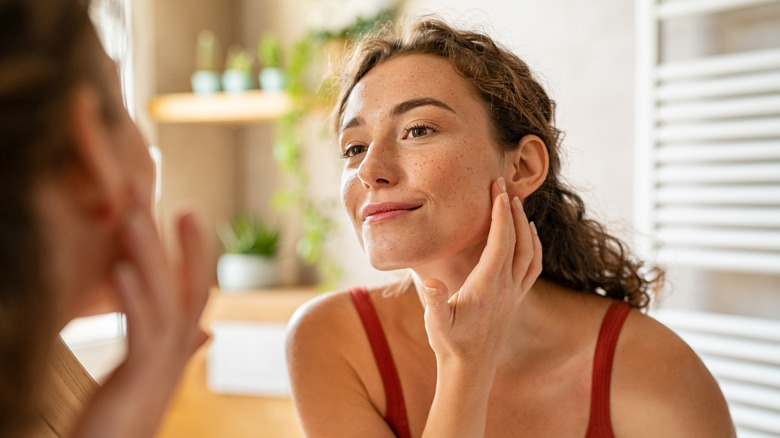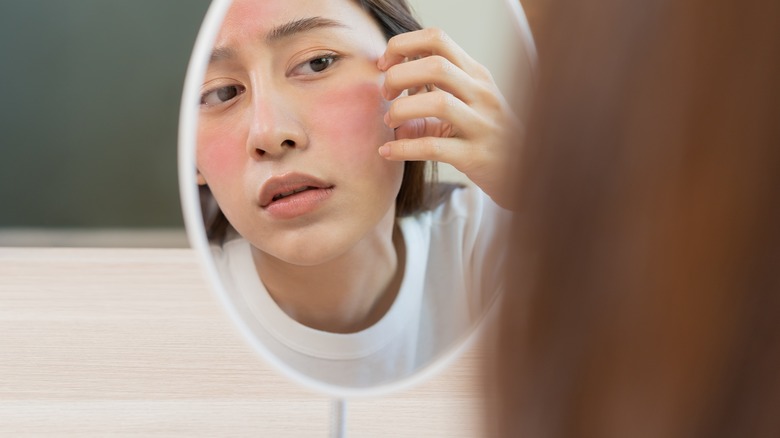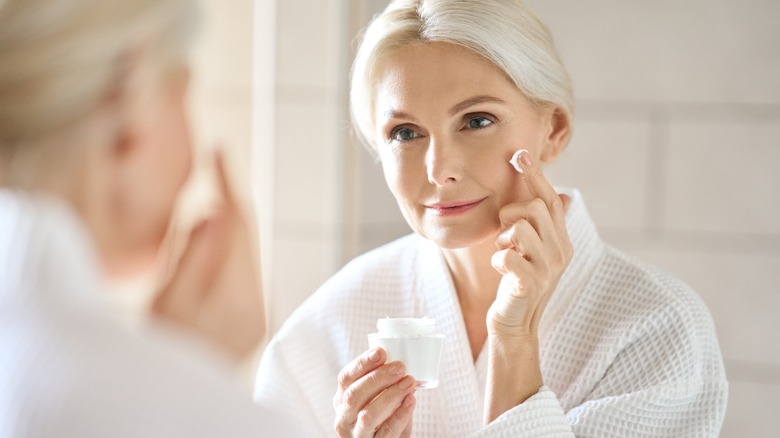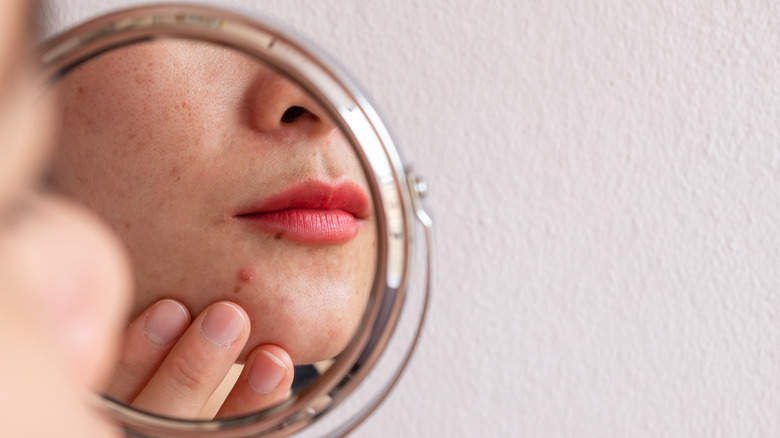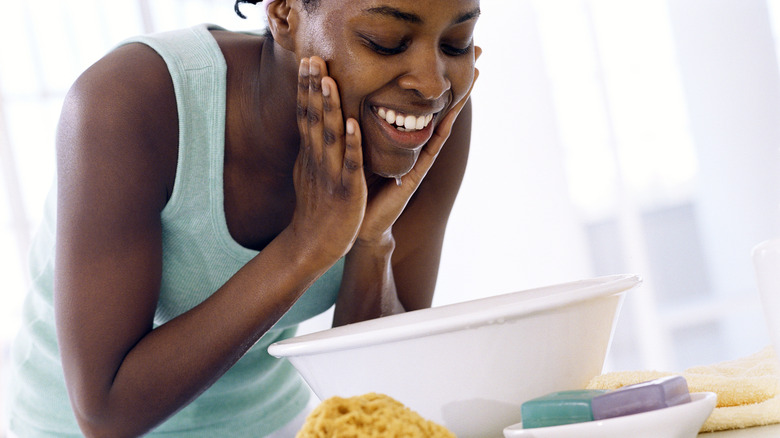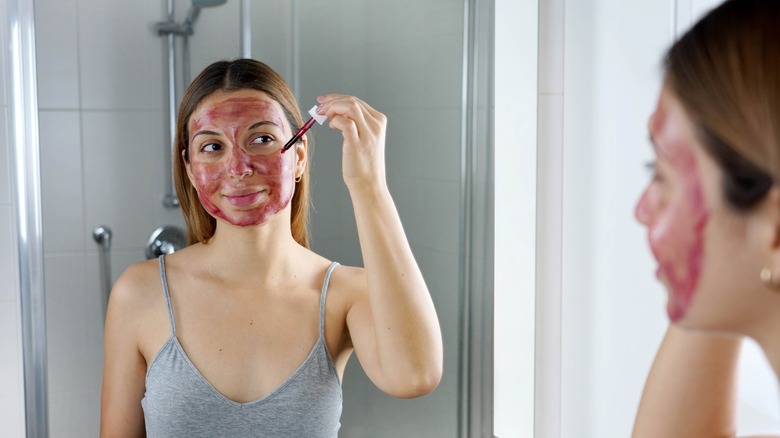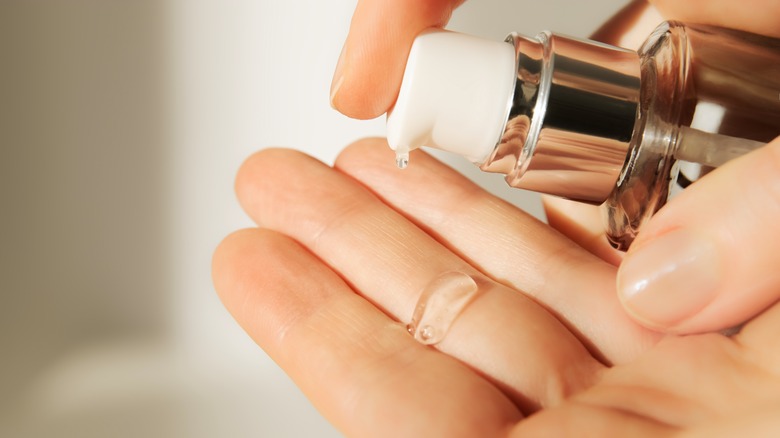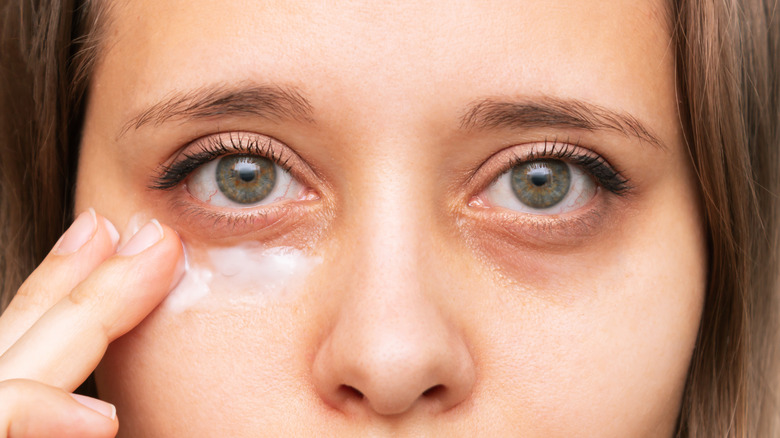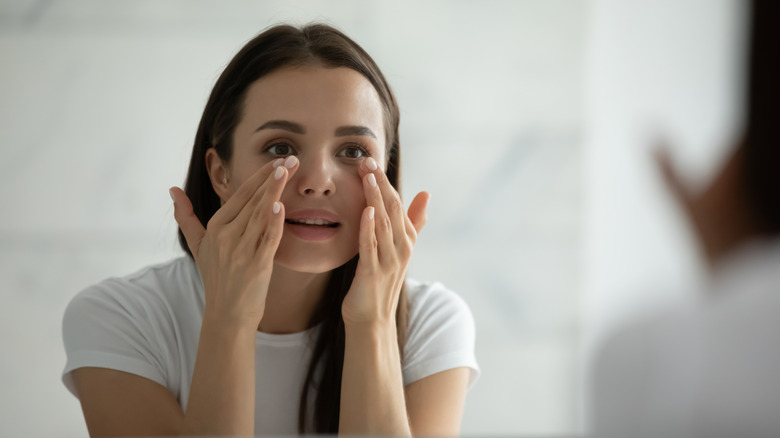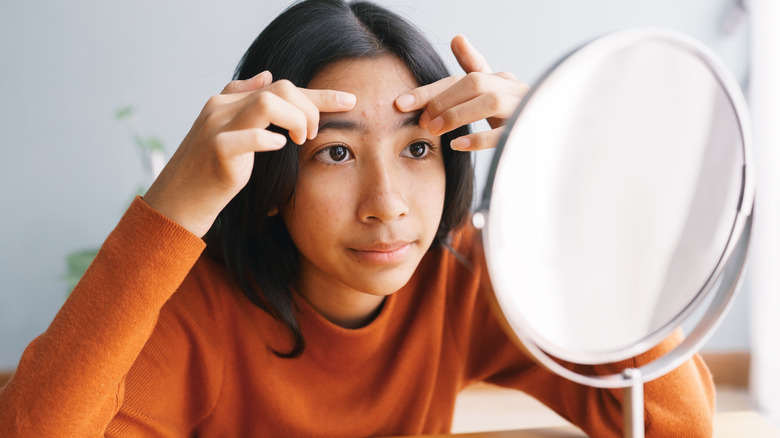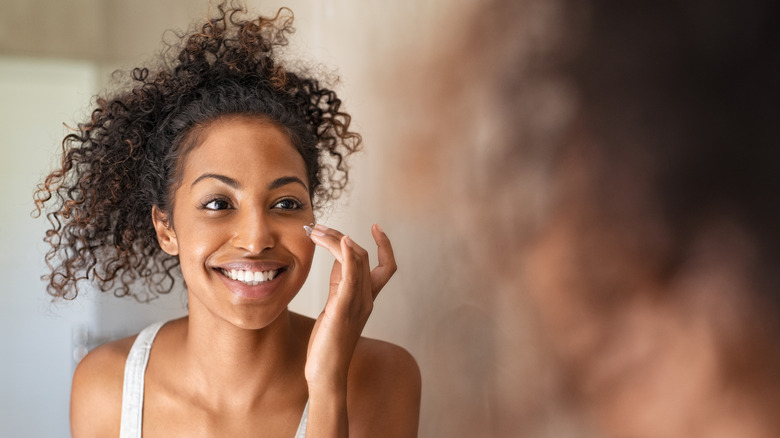Myths About Retinol That You Need To Stop Believing
We may receive a commission on purchases made from links.
Retinol has been one of the most well-known skincare ingredients for decades, and many people swear by it. According to Healthline, retinol is a vitamin A derivate and it is a less harsh version of retinoids. While retinoids like tretinoin, isotretinoin, and tazarotene are given through a prescription, retinol products can be purchased over the counter. Even though it often gets confused with an exfoliant, retinol is actually an antioxidant. Once applied to the skin, retinol reacts with the skin's enzymes and it converts to retinoic acid (via The Skin Spot).
So what does retinol actually do? In the world of skincare, retinol is almost considered a magic product as it can tackle plenty of skincare problems. "Using a well-formulated and stable product with retinol will visibly reduce the appearance of sun damage, brown spots, lines, wrinkles, and large pores," esthetician Renée Rouleau explains to Byrdie. "It can stimulate the metabolism of skin cells and encourage collagen production. Its magic is in its ability to resurface the skin's texture for a smoother, more even-toned look."
However, as with most skincare ingredients, there are plenty of myths out there. From what retinol can or cannot do to just how it needs to be applied, we're clarifying what's true and what isn't when it comes to one of the most popular skincare ingredients!
Going through a purge period
Anyone who knows what retinol is has probably also heard of the "retinol purge." The period usually begins after you first introduce retinol to your skincare routine and it can last for a couple of weeks — even a month. The purge comes with dry and flaky skin, acne, and redness. "Purging occurs when a new product is introduced to the skin that can increase skin [surface] turnover to get rid of the dead skin, such as retinoids and exfoliants," Dr. Marisa Garshick tells Youth to the People. "It can lead to a temporary increase in breakouts either by bringing smaller breakouts to the surface or by triggering new breakouts and clogged pores associated with the accelerated skin turnover."
According to celebrity aesthetician Joshua Ross, while plenty of people experience purging, not everyone has to go through that phase. "Some people may not purge at all and could only experience redness and flaking skin during the initial usage phase," Ross tells MindBodyGreen. In fact, those who are prone to acne are more likely to experience a purge period as the acne they already have is coming to the skin's surface. "During a purge period, blemishes that you may have experienced anyway come to the surface sooner as a result of the retinoid increasing skin [surface] turnover," Dr. Garshick reveals (via Youth to the People).
The best way to avoid going through the purge period is to introduce retinol slowly. In the beginning, apply your retinol product sparingly and only once a week. Eventually, you can try applying it more frequently, depending on how well your skin handles it.
Retinol works best if you use it daily
As with plenty of skincare products, most people believe that the more they use something the better it will work. However, with retinol that approach can have the completely opposite effect. Of course, in the beginning, you should use your retinol products sparingly — but once your skin adapts you still don't need to use retinol on a daily basis. Dermatologist Julia Carroll suggests that three times per week is more than enough when it comes to retinol application (via Chatelaine). Paula's Choice also recommends using retinol three times per week; however, the brand does mention that the lower the percentage of retinol in the product the more frequently you can use it.
Having this said, there is nothing wrong with using retinol every day if your skin is happy with that. However, if you're also using other products that can cause irritation, skipping your retinol cream occasionally won't make it less effective. Too many products used at the same time can damage your skin barrier, so taking a break when you notice itchiness, roughness, or redness is advised (via Healthline). "You want to take away anything that might be irritating. Then you can swap over to a gentle moisturizer because you don't want to introduce something particularly irritating or problematic," board-certified dermatologist Dr. Ranella Hirsch tells Today.
Retinol will cure your acne
Those who decide to incorporate retinol into their skincare routine to fight acne shouldn't expect a miracle. Yes, retinol can help as it unblocks pores and helps maintain a healthy cell turnover (via Medical News Today), but a lot of times neither of the two is what causes the acne. If you're struggling with hormonal acne, retinol won't necessarily help you as the cause of your acne isn't on the skin's surface, which is what retinol targets. However, even though it might not cure your acne, it can still help it be less apparent and any flare-ups might go away quicker, per Midland Skin.
Retinol has been used to treat acne since the 1970s, and because it helps reduce sebum production it can heal mild acne (via Medical News Today). Unfortunately, those who are suffering from severe acne won't see much progress from retinol — instead, they should opt for tretinoin, which is a stronger type of retinoid that usually requires a prescription.
You need to wait after washing your face before you apply retinol
Most people have heard that retinol should not be applied to wet skin. In fact, plenty believe that they need to wait a while after washing their face to apply it. However, retinol isn't more irritating if you apply it to wet skin.
Board-certified dermatologist Dr. Shari Marchbein reveals to In Style that it isn't necessary to wait for your skin to be fully dry to apply your retinol product. "As a busy mom, I can guarantee that I've never waited the recommended 30 minutes after cleansing my face to apply a retinoid," Dr. Marchbein claims. "In contrast, there is also no good evidence that applying it to wet skin enhances absorption, so I recommend gently cleansing the skin at night then pat it dry and apply a pea-sized amount of retinoid to the entire face."
However, applying retinol to wet skin will make the product absorb more deeply, which isn't really something that we want retinol to do, as we mostly want it to do its magic on the surface of the skin (via Well + Good). Dermatologist Loretta Ciraldo explained to Well + Good where the myth comes from. "In the 1980s, when we just started using Retin-A and tretinoin for anti-aging, we instructed women to wash and wait 20 minutes before applying the Retin-A," Ciraldo says. "At this time, dermatologists believed waiting was the best way to minimize any irritation from the product. Immediately after washing, while our skin is slightly damp, you do get enhanced absorption." Today, however, formulas containing retinol are much more advanced and the waiting can easily be skipped.
You shouldn't use retinol with AHAs and BHAs
If you have sensitive skin, using retinol with alpha-hydroxy acids or beta-hydroxy acids probably isn't the best idea as it could lead to damaging your skin barrier (via Paula's Choice). However, if your skin isn't sensitive you can give retinol and exfoliating acids a chance. In fact, per Healthline, studies from 2015 claim that "combining retinol and an AHA exfoliant together can be an effective combination for hyperpigmentation caused by acne."
For Forbes, Dr. Nancy Samolitis, a board-certified and California-based dermatologist, explains just why some may not want to combine the two. "The initial few weeks of exposure may be met with some redness, sensitivity, or dryness. But as the skin strengthens, those side effects go away. Because chemical exfoliants (AHAs and BHAs) can have the same side effects, it may not be smart to combine them in the beginning, but they can be added into the regimen as the skin gets more tolerant," Samolitis says.
If you decide to incorporate both retinol and exfoliating acids into your skincare routine, make sure your skin gets used to one before you start using the other. And in order to prevent irritation and help the skin's barrier remain healthy, make sure you use a nourishing moisturizer that contains ingredients like ceramides, hyaluronic acid, glycerin, and panthenol, per LA Clinica.
A low percentage of retinol won't do much
Retinol speeds up collagen production, which means that even the smallest percentage will work. According to Paula's Choice, "percentages of 0.01% retinol or greater are proven to be effective at improving multiple signs of aging, reducing pore size and improving the overall health of your skin." In fact, products that have a smaller percentage of retinol are perfect for avoiding the "purge" stage, and they are a great choice for anyone with sensitive skin as well.
Kiehl's claims that even a concentration under 0.3% will show benefits like "minimizing the appearance of wrinkles, fine lines, and pores." The brand recommends a lower percentage of retinol for anyone who has dry and sensitive skin, which means that no one needs to sit out on this skincare trend. Keep in mind that less is more when it comes to applying your retinol product. Most experts recommend applying a pea-sized amount in a thin layer all over your face, according to the Cleveland Clinic.
Retinol makes your skin more sensitive to sunlight
Everyone should use products with SPF during the day, regardless of whether they use retinol or not. Using retinol to fight the sun damage you have on your skin and then going into the sunlight unprotected is definitely a waste of time. Per Molly Sims, retinol does not make your skin more susceptible to sunburns. "This is not true. Studies have shown that retinoids do not burn you faster," Dr. Lina Kennedy tells the outlet. "Newer forms are even better than older ones. You will have to wear sunscreen, but not because of the risk for sunburn."
Retinol does not make your skin more sensitive to the sun. Instead, it is the retinol itself that is sensitive to it. "Retinols themselves are sensitive to sunlight, so if you applied a retinol product and exposed your skin to the sun immediately, the retinol would be less effective, but the increased risk of sunburn is slim to none," Dr. Nancy Samolitis reveals to Forbes. This is why it is advised to apply retinol at night and use sun protection in the morning since you don't want that retinol that your skin soaked up to stop working.
You shouldn't apply retinol around your eyes
One thing that most people who use retinol have heard is that it isn't safe to apply it around your eyes. However, plenty of people get wrinkles in that area, and retinol is known to help treat those, which is why it would actually be a shame to not use it around your eyes.
According to Dr. Nancy Samolitis, applying retinol around your eyes is completely safe, as long as you apply it carefully. "I feel that the eye area can definitely benefit from the collagen-boosting properties of retinol," says Dr. Samolitis. "Just make sure you apply a generous amount of moisturizing eye cream immediately after retinol. And be careful not to use too much product at once or to let it get into the eye," the expert adds (via Forbes).
If your skin isn't sensitive, you might be able to get away with using your regular retinol product around your eyes; however, there are specially formulated eye products with retinol on the market. "These usually contain lower concentrations and are more hydrating than what you use on your face," Gretchen Frieling, M.D., tells Well + Good.
Retinol makes the skin thinner
In reality, the opposite is true: retinol stimulates collagen production (via Healthline), which in turn helps make the skin thicker and healthier. However, it does remove that dead layer of skin, which is where the myth comes from. "People believe retinol thins the skin which is true. However, it only thins the topmost layer (stratum corneum) which is made of dead skin cells (also known as keratinocytes)," board-certified dermatologist Dr. Kellie Reed tells Forbes.
However, if you're overusing retinol and not using enough sun protection, your skin might be thinning. "Retinol removes and exfoliates unnecessary dead skin cells, which causes the basal layer — or the stem cell layer of the skin — to produce newer and more healthy cells," Devika Icecreamwala, M.D., reveals to InStyle. "If you're overusing your retinol, or if you're using a retinol that's too strong for you, it can lead to peeling, irritation, and excessive dryness, which may have led to retinol's association with skin thinning. This will make your skin look older and accentuate wrinkles. Sunburn causes skin thinning, so the only advice would be to protect your skin from the sun and use retinol appropriately."
Young people can't use retinol
Because retinol is widely known as an anti-aging treatment, many believe that younger people shouldn't use it. However, there is no age limit to retinol as it can treat numerous skin conditions such as acne, psoriasis, warts, and more, according to WebMD. In fact, retinol is frequently used to help teenagers minimize the appearance of their acne (via Open Formula).
Since teenage skin doesn't need the anti-aging properties that retinol offers, a cream with a low percentage of retinol will be enough. According to Healthline, a skincare product that contains between 0.25% and 1.5% retinol will suffice to help the acne heal quicker. Retinol is also known for making pores appear smaller, which is another reason why someone under the age of 30 might choose to give retinol a chance (via Holland & Barrett). Retinol can also help with hyperpigmentation, per Dermcollective, which is often associated with acne. The way the body sometimes responds to acne inflammation is by increasing melanin in the affected area, which causes dark spots that tend to stay even after the acne has healed.
While most people start using retinol in their 30s, starting in your 20s is advised, as that is the time period when you begin losing collagen (via Holland & Barrett). "Collagen literally holds us together—it makes up 30% of the body's protein and 70% of the skin's protein," functional medicine practitioner Robert Rountree, M.D., tells MindBodyGreen. "The No. 1 cause of skin aging is the loss of collagen. When we are young, our bodies produce more collagen than we break down. That balance tips the wrong way with age since tissue regeneration decreases."
You'll see results in a month
While retinol can be a miracle product, it takes consistency and patience to see results. Yes, some people are lucky enough to notice a difference in a couple of weeks, but for most people, it takes at least three months (and for some even half a year) before they notice that their skin is improved (via Healthline). "Retinol is perhaps the best-studied ingredient we have over the counter," says dermatologist Joshua Zeichner. "But visible improvements can take several weeks to start kicking in, so it's important to be patient and stick to your routine" (via Elle).
According to Gary Fisher, M.D., a professor of dermatology at the University of Michigan Medical School, the average is three months. "Many over-the-counter formulas claim you'll see results within weeks," says Dr. Fisher. "But in my experience, it takes an average of 12 weeks for retinoic acid to produce noticeable changes in the skin. So stick with it for at least that long to see the benefits," the professor tells Allure. Retinol might not work quickly, but those who have used it regularly for months swear by it. After all, good things come to those who wait!
